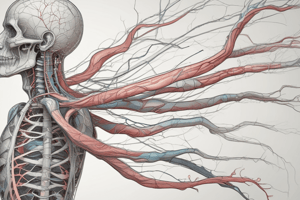Podcast
Questions and Answers
The cerebellum is responsible for higher-order functions such as thinking and learning.
The cerebellum is responsible for higher-order functions such as thinking and learning.
False (B)
Neurotransmitters are released at the dendrites of a neuron.
Neurotransmitters are released at the dendrites of a neuron.
False (B)
The Peripheral Nervous System (PNS) includes the brain and spinal cord.
The Peripheral Nervous System (PNS) includes the brain and spinal cord.
False (B)
The synapse is the gap between the dendrites of two adjacent neurons.
The synapse is the gap between the dendrites of two adjacent neurons.
The brainstem regulates non-essential functions such as hunger and thirst.
The brainstem regulates non-essential functions such as hunger and thirst.
The autonomic nervous system is responsible for voluntary actions.
The autonomic nervous system is responsible for voluntary actions.
What is the main difference between somatic and autonomic reflexes?
What is the main difference between somatic and autonomic reflexes?
What is the order of the reflex arc?
What is the order of the reflex arc?
What is the purpose of the withdrawal reflex?
What is the purpose of the withdrawal reflex?
What are the three main characteristics of reflex actions?
What are the three main characteristics of reflex actions?
What is the role of the integration center in the reflex arc?
What is the role of the integration center in the reflex arc?
Give an example of an autonomic reflex.
Give an example of an autonomic reflex.
Flashcards are hidden until you start studying
Study Notes
Nervous System
Functions:
- Controls and coordinates various body functions
- Interprets and responds to stimuli
- Enables communication between different parts of the body
Structure:
- Central Nervous System (CNS):
- Brain
- Spinal cord
- Peripheral Nervous System (PNS):
- Somatic nervous system (voluntary actions)
- Autonomic nervous system (involuntary actions)
- Sensory neurons (transmit sensory information)
Parts of the Brain:
- Cerebrum:
- Divided into two hemispheres (left and right)
- Responsible for higher-order functions (thinking, learning, emotion)
- Cerebellum:
- Coordinates muscle movements and balance
- Brainstem:
- Connects cerebrum and cerebellum to spinal cord
- Regulates essential functions (breathing, heart rate, blood pressure)
Neurons:
- Structure:
- Dendrites (receive signals)
- Cell body (contains nucleus)
- Axon (transmits signals)
- Transmission of Signals:
- Electrical impulses (action potentials) travel along axon
- Chemical signals (neurotransmitters) released at synapse
- Binding of neurotransmitters to receptors on adjacent neuron
Synapse:
- Gap between two neurons
- Chemical transmission occurs across synapse
- Strengthening or weakening of synaptic connections involved in learning and memory
Nervous System
Functions
- Coordinates and controls various body functions
- Interprets and responds to stimuli
- Enables communication between different parts of the body
Structure
- Consists of Central Nervous System (CNS) and Peripheral Nervous System (PNS)
- CNS includes brain and spinal cord
- PNS includes somatic nervous system, autonomic nervous system, and sensory neurons
Central Nervous System
- Brain interprets and responds to stimuli
- Spinal cord transmits messages between brain and rest of body
Peripheral Nervous System
- Somatic nervous system controls voluntary actions
- Autonomic nervous system controls involuntary actions
- Sensory neurons transmit sensory information
Brain
Cerebrum
- Divided into two hemispheres (left and right)
- Responsible for thinking, learning, and emotion
Cerebellum
- Coordinates muscle movements and balance
Brainstem
- Connects cerebrum and cerebellum to spinal cord
- Regulates essential functions (breathing, heart rate, blood pressure)
Neurons
- Receive signals through dendrites
- Cell body contains nucleus
- Transmit signals through axon
- Electrical impulses (action potentials) travel along axon
- Chemical signals (neurotransmitters) released at synapse
- Neurotransmitters bind to receptors on adjacent neuron
Synapse
- Gap between two neurons
- Chemical transmission occurs across synapse
- Strengthening or weakening of synaptic connections involved in learning and memory
Reflex Actions
Definition and Characteristics
- Reflex actions are rapid, automatic responses to stimuli that don't involve the brain.
- They're involuntary, meaning they can't be controlled or stopped once started.
- Reflexes are characterized by speed, automaticity, and specificity.
Types of Reflexes
- Somatic reflexes involve skeletal muscles and are voluntary, such as withdrawing a hand from a hot surface.
- Autonomic reflexes involve smooth muscles and are involuntary, such as the pupil constricting in bright light.
Reflex Arc
- A reflex arc is the pathway by which a reflex action occurs.
- It consists of:
- Receptor: detects the stimulus
- Sensory neuron: transmits the signal to the spinal cord
- Integration center: processes the information and sends a response signal
- Motor neuron: transmits the response signal to the effector
- Effector: carries out the response, such as a muscle contraction
Examples of Reflex Actions
- Withdrawal reflex: withdrawing a hand from a hot surface
- Blinking reflex: closing the eyelids to protect the eyes from dust or other particles
- Knee-jerk reflex: straightening the leg when the patellar tendon is tapped
- Coughing reflex: expelling air from the lungs to remove an irritant from the trachea
Studying That Suits You
Use AI to generate personalized quizzes and flashcards to suit your learning preferences.





